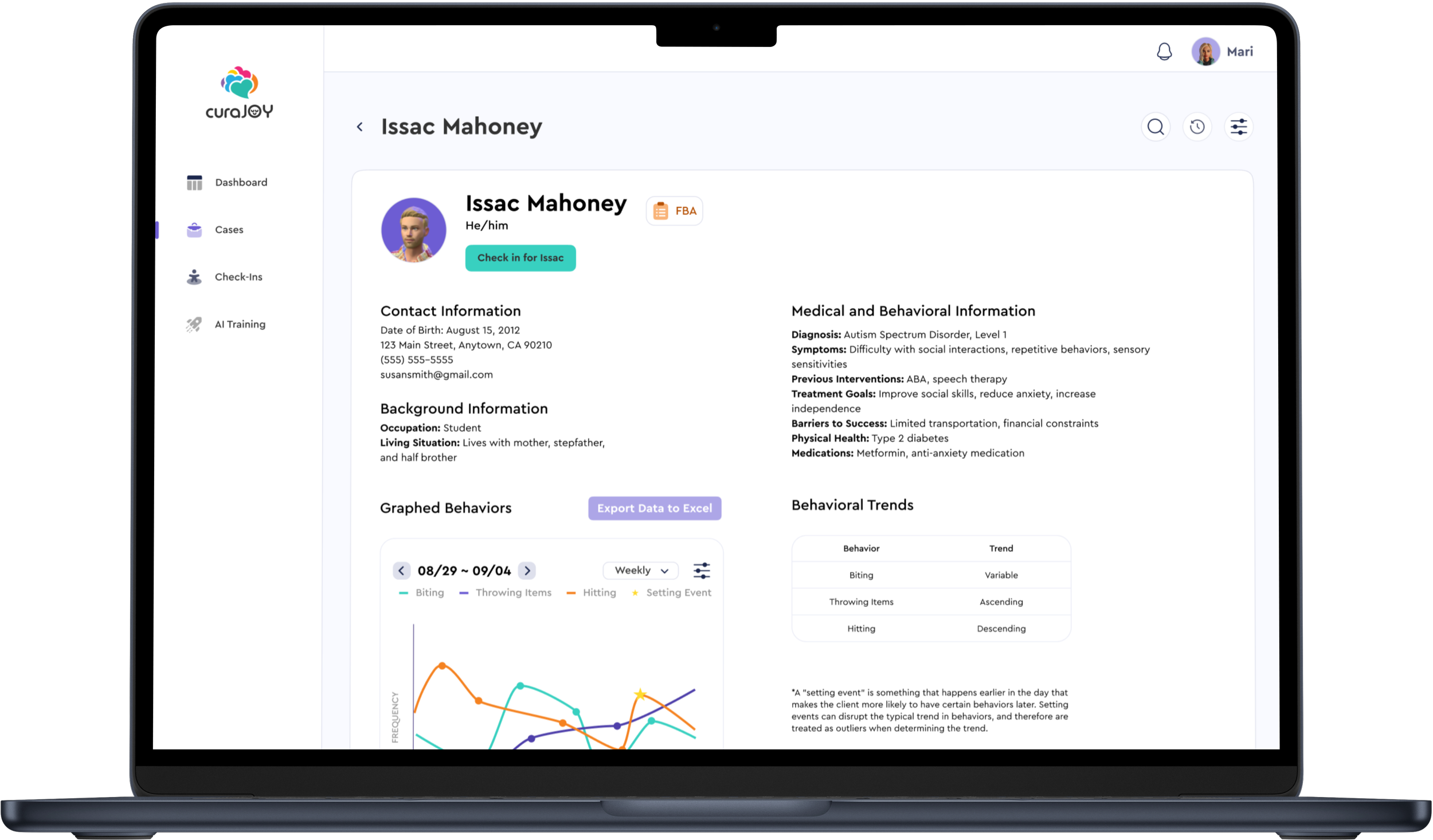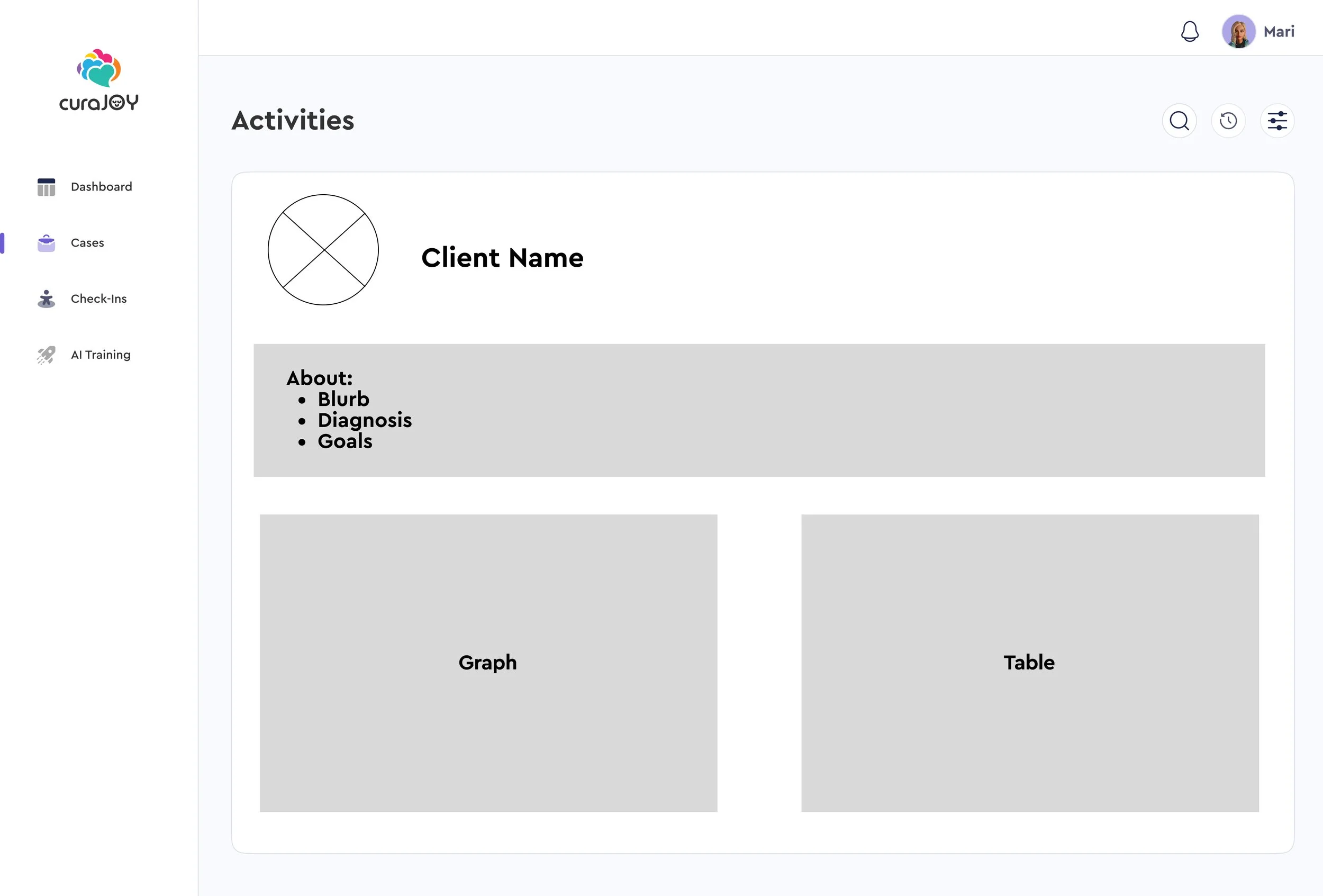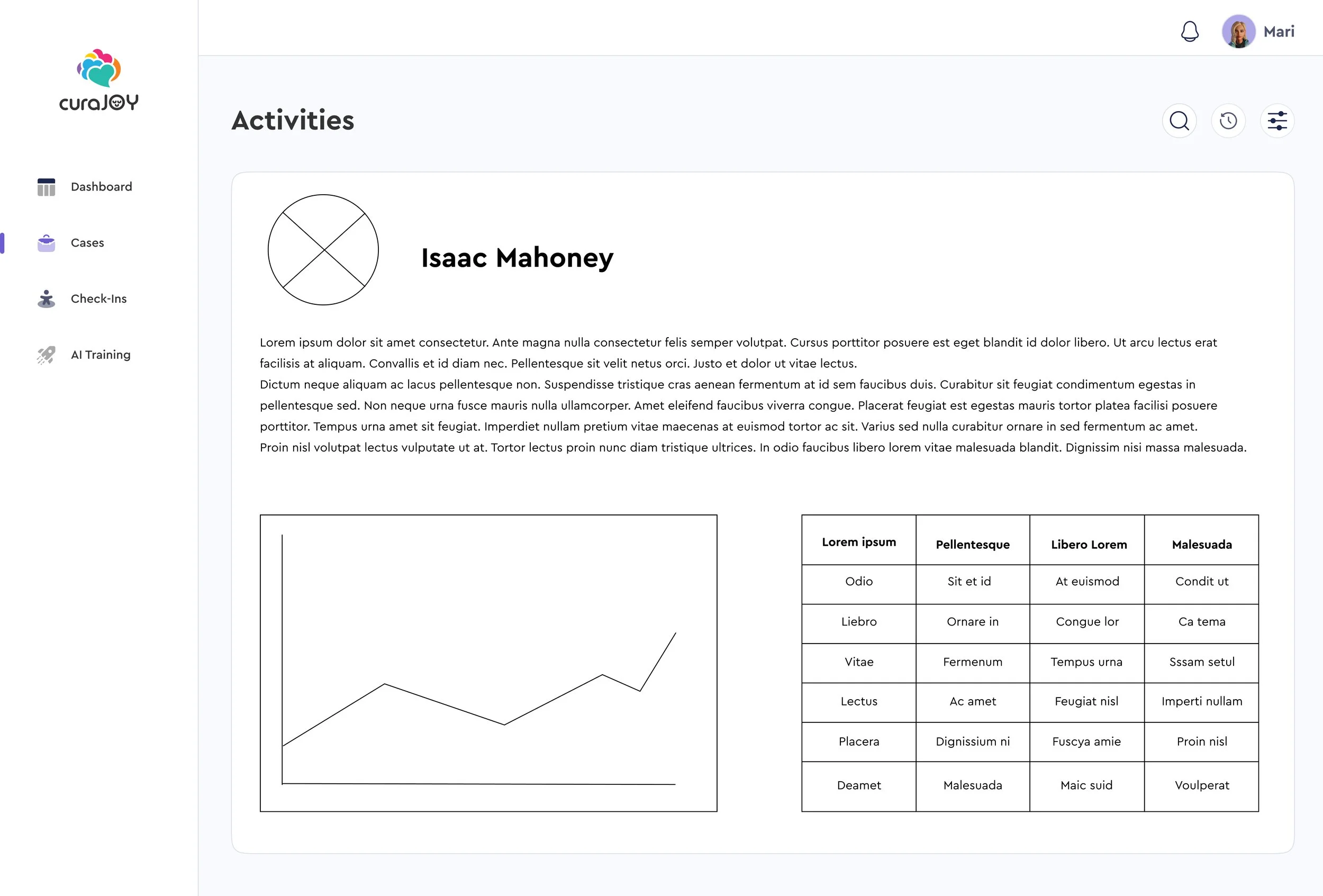Streamlining Client Management Tools with curaJOY
Project Type: Web application
Team: Natalie Codina (UX Designer) Jessica Peng (Product design manager), Haley Scheer (UX Researcher), Isidora Vladic (UX Designer)
Role and Responsibilities: Led the creation of the Single Client Page, and assisted in conducting user testing and user interviews
Duration: 2 week design sprint
Tools: Figma, Usertesting.com
Methods: User testing, user interviews
The Challenge
curaJOY is a comprehensive digital platform designed to support mental health and behavioral improvement. It helps users track emotional well-being, habits, and progress through tools that promote self-awareness and growth. However, our challenge was the lack of a dedicated, user-friendly interface for professionals like behavioral analysts, who need specialized tools to manage client data and track behavioral progress in a streamlined, efficient way. These professionals rely on data to make informed decisions, but existing tools were often cumbersome or lacked necessary features.
Our goal was to create a tailored solution that empowers behavioral analysts to easily manage client data, track behavioral progress, and make data-driven decisions—all within an intuitive and accessible interface.
While curaJOY aims to one day serve a broad spectrum of mental health professionals, tight deadlines led us to focus exclusively on behavioral analysts as our primary users.
Key Questions:
How can we design a system that allows behavioral analysts to efficiently manage and view detailed client data?
What are the essential features and data points that support the daily tasks of behavioral analysts in their client management work?
How can curaJOY fill the gaps left by existing tools used by behavioral analysts, such as CentralReach?
Why expand into client management?
Expanding curaJOY to include a client management system would bridge the gap between self-care and professional support. Many existing tools for professionals are fragmented or lack essential features, creating an opportunity for curaJOY to offer a streamlined, integrated solution. By adding these tools, curaJOY can become a holistic platform that supports both individual users and the professionals guiding them, improving outcomes for everyone. Without a dedicated interface for professionals, curaJOY risks missing a crucial opportunity to enhance long-term well-being through seamless professional collaboration, positioning itself as a versatile tool in the mental health and behavioral improvement space.
Our Solution
We developed 3 key pages for behavioral analysts:
Personalized Dashboard: A customizable space providing at-a-glance insights, such as upcoming sessions, progress summaries, and important alerts. This enabled analysts to stay organized and focused on client priorities.
Client Management Page: A centralized hub displaying all clients with filtering, searching, and sorting features, making it easy to track clients’ progress and behaviors.
Single Client Page: A detailed view of individual client data, including long-term behavioral trends, progress metrics, session notes, and personalized goals. I took the responsibility of solely ideating, designing, and reiterating this portion of the project.
Scroll down to learn more about how we made these designs come to life
User Interviews
Before starting, we had 5 days to collect data that would be used to ideate and produce our initial designs. Our primary method was through user interviews, where we interviewed 7 behavioral analysts.
In these interviews, we sought to understand the following:
The scope of their role and day-to-day tasks
How they interact with clients
What current tools they use
What gaps exist in current tools that they wish to see from our product
Here is what we learned:
The biggest pain points in current client management systems: poor data visualization, time-consuming processes, and inadequate tool functionality
Necessary features we must implement include the ability to conduct Functional Behavioral Assessments (FBAs), create Behavioral Intervention Plans (BIPs), and track behavioral interventions
Desirable features that current systems do not have include customizable dashboards, task prioritization, and AI assistance for FBAs/BIPs
Initial Designs
Based on feedback from our interviews, I designed wireframes for the single client page. The design focused on providing analysts with a comprehensive view of each client’s behavioral history, including behavior patterns, progress metrics, and real-time data from ongoing sessions.
User Testing
We conducted user testing with five behavioral analysts using high-fidelity prototypes. User testing results were used to iterate based on feedback, ensuring that analysts can easily navigate and interact with the page’s information. During testing, we focused on flow, usability, and functionality of the pages.
Through user testing, we were able to improve the visibility of important metrics, refine navigation, and add customization options for goal-setting and note-taking for our final deliverable.
Final Design
The final design allows behavioral analysts to:
Easily manage and view all their clients in one place.
Track client progress over time using long-term behavioral data.
Set and review client-specific goals and notes within a single, unified interface.
These new features provided behavioral analysts with tools tailored to their specific needs, making their workflow more efficient and helping them offer better support to their clients.
Key Takeaways
Research is the backbone to not only design, but company time: Thorough research ensures the design process meets real user needs. By interacting directly with behavioral analysts, we avoided wasting time and resources on designs that might not work for them. This approach allowed us to create solutions that are both desirable and competitive with existing platforms.
Time is of the essence: The two-week sprint required quick decisions and clear priorities. To deliver quality results, we narrowed our focus to one user group and prioritized high-impact features for them, rather than spreading efforts too broadly.
Collaborative design is powerful: This project was my first experience collaborating with a team of experienced designers and researchers. It taught me that diverse perspectives and skillsets can bring about unique solutions that I might’ve not ideated on my own.
If I had unlimited time, money, and resources, here’s what I would do differently…
Expand client management tools to serve a broader range of professionals: Currently, the client management pages are designed for behavioral analysts, but curaJOY supports a wider audience, including therapists, doctors, and other professionals. With more time and resources, I’d explore how to adapt these tools to meet the needs of different specialties, ensuring that all professionals using curaJOY can efficiently manage clients, track progress, and access relevant insights tailored to their field.
Improve the accessibility of behavioral graphs for both digital and print use: The current line graph uses color to differentiate data, but behavioral analysts often print these graphs, and not all offices have color printers. This makes it difficult to interpret in black and white. While I briefly explored patterned graphs, they were visually cluttered, making them also difficult to read. With more time and resources, I’d invest in finding a solution that balances accessibility for print while maintaining a visually appealing and intuitive experience on the curaJOY app.
Conduct broader user testing and research: Due to strict time constraints, we had limited opportunities to expand our research, resulting in only 7 behavioral analyst interviews. With more time and resources, I would prioritize reaching a larger and more diverse pool of users to gather deeper insights. More interviews and research would help us refine our solutions, ensuring they meet the needs of a wider range of professionals.




